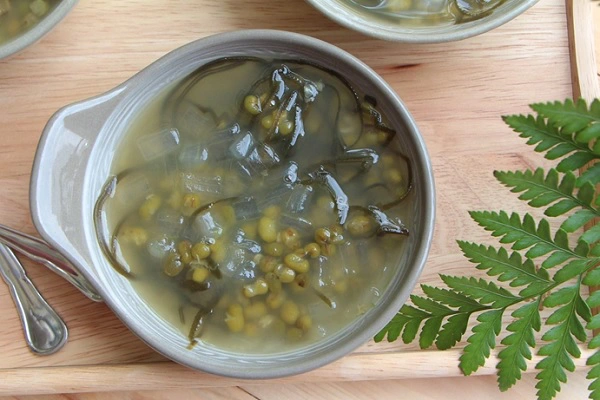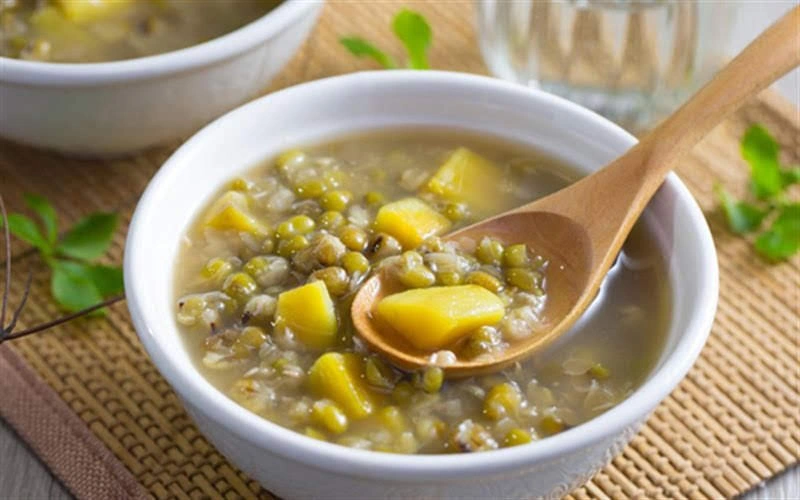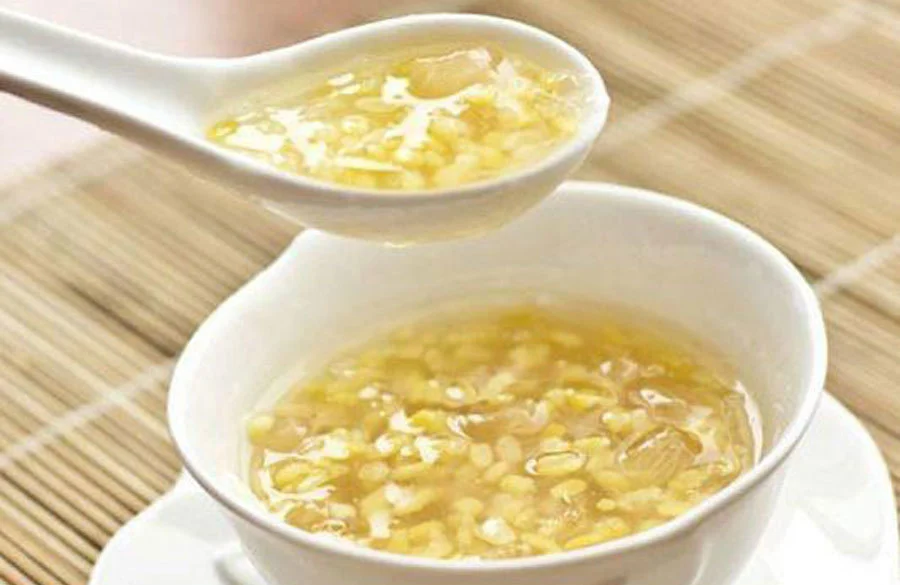Recipes
Title: Soups for the summer
The original article was dated: August 25, 2021
Disclaimer: This translated article is for informational purposes only. It shows similarities among principles of Oriental Medicine across the board. Contraindications for excessive or regular consumption of mung beans should be noted.
Many in Asia prepare mung beans plain with sweeteners. However, if it is combined with other food, nourishment of health is believed to double according to an article included in the reference. When red beans, aloe vera, pumpkin or lotus root are added to plain sweet mung bean soup, there is claim that mung bean soup’s ability to nourish the body is enhanced.
Mung beans are known as a heat-relieving food, and are especially delicious when cooked into sweet soups. In addition, mung beans Mung beans are also rich in potassium, copper, thiamin (vitamin B1), pantothenic acid (vitamin B5), magnesium, phosphorus, zinc, iron and manganese. They provide smaller amounts of selenium, calcium, choline and vitamin K. They also provide a significant amount of fiber, folate and complex carbohydrates and are protein rich. They provide minimal amounts of fat but are a nutrient dense source of copper and other minerals (Muinos, 2021).

Mung beans are sweet flavored with cool properties, enters the heart and stomach channels, has cold properties and generally viewed as non-toxic, builds yuan Qi, clears heat, cools the liver, brightens the eyes, helps ulcers, carbuncles and sunstroke. For those who do not fall under the list of contraindications, eating mung beans regularly can help lower blood pressure, prevent arteriosclerosis and improve liver health.
Ingredients to combine with mung bean are as follows:
1. Red beans
In Oriental medicine, red beans have a sweet and sour flavor, neutral properties, clearing heat functions that are detoxifying, tonifies the spleen, benefits the stomach, are diuretics and can treats rashes, pimples, hives and diseases of the skin. This food is rich in vitamins B1, B2, protein and minerals. If eaten in large quantities, there is a claim that it can nourish blood, and improve cardiovascular functions. In addition, red beans are high in fiber. Thus, promote the excretion of toxins from the body while helps with lose weight.
Based on general practitioner Bui Dac Sang (Hanoi Oriental Medicine Association), combining mung beans with red beans while cooking will help enhance the soup’s flavor, while exponentially improving health when eaten. Three hundred (300) grams each of mung beans, red beans and black beans boiled with licorice and eaten within seven (7) days, pulp and liquid, can treat thirst, detoxify, clear heat, promote urination, reduce gas and prevent summer diseases.
2. Aloe vera
Sweet mung bean soup, aloe vera and rock sugar is a delicious soup on hot days. According to many sources, Aloe vera has tremendous cooling tendencies and used both internally and externally. For this reason, when combined with mung beans, the combined cooling properties help purify and some claim to aid in weight loss. The combined flavors, unique sweetness, crunchy and nutty flavors are considered gentle on the body and refreshing when consumed.

3. Pumpkin
Vitamins A and C in pumpkins help boost the immune system, improve skin health, prevent stroke, help lose weight and improve colon health.
According to Chinese medicine, pumpkins are cool in nature. Pumpkins kill worms, resolve dampness, reduce fever, relieve pain, stops dysentery and benefits those with diabetes. Dysentery, diabetes, lower extremity ulcerations, eczema, stomachaches, steaming bone disorders and intestinal worms are conditions they can help. Pumpkins are also antidotes for opium according to Chinese Medicine.
In the west, it was discovered that pumpkins are high in copper, fiber, folate, and manganese, calcium, potassium, magnesium and Vitamins A, B1, B6, and C. Nutrients that supports heart health by maintaining blood pressure. Added to this, pumpkins have fiber that can play a part in lowering blood pressure as well as cholesterol.
Therefore, dishes that combine mung beans and pumpkins are believed to reduce blood sugar levels, have cooling and detoxifying effects, and considered good dieatry support for those who are diabetic. From these two ingredients, nutritious dishes can be created, such as mung bean pumpkin porridge and mung bean pumpkin sweet soup.

4. Lotus root
According to Oriental medicine, lotus root has a sweet flavor and neutral in properties. It nourishes the spleen, lungs, stops bleeding, in particular the nodes, and is sedating. In addition, lotus root is a food with high nutritional value. It contains calcium, iron, magnesium, phosphorus, potassium, sodium, Vitamin C and folate.
Because of its properties, lotus roots cooked with mung beans could potentially enhance the functions of the stomach and spleen. It is said to even warm the stomach. It nourishes the body, regulates blood pressure and considered good support for the liver and gallbladder and those with high blood pressure.

Contraindications:
1. Women who are on their menstrual cycle
Mung beans tastes sweet and is cold in nature and have draining properties as seen in its ability to detox toxins. Therefore, it is advised for women to avoid sweet and cold food so to not allow mung bean’s flavor and temperature to harm the uterus, cause or make menstrual cramping worst, and affect or aggravate menstrual flow.
2. People with stomach problems and frequent diarrhea
Being cold and draining in nature, mung bean can be taxing on the stomach in those with a weak stomach especially those who frequently have diarrhea. Those with weak a gastrointestinal system prone to diarrhea may want to avoid eating mung beans. Eating mung beans may cause a relapse in such conditions. Therefore, patients with diarrhea, or poor stomach functions, should avoid eating green beans to prevent gastrointestinal issues. This may include children, the elderly and those who are extremely weak.

3. People who often have cold hands and feet
People who tend to be cold, characterized by cold hands and feet, lack of energy and loose stools, should not eat green beans because it can cause diarrhea, dehydration, and muscle and joint pain causing existing conditions and symptoms to worsen. Bloating could also arise in those with cold patterns.
4. People who are taking Oriental medicine
Because green beans have a detoxifying effect, it can neutralize some herbs and teas like some leafy greens do. Ginseng (Panax ginseng, Ren Shen) is an example of an herb that can be neutralized by mung beans. So, if you are drinking oriental medicine herbal decoctions or teas, it is best to avoid everything with mung bean in it including mung bean soup. It can render some herbal ingredients ineffective. With that said, should someone be taking a formula not suitable for them, mung bean can neutralize the effect.
As a final note, anything we consume should help us reach the state of balance, according to TCM, or homeostasis, according to western medicine. Always listen to your body.
References:
Acupuncture.com, M. (1996). Mung beans. Acupuncture.Com - Mung Beans - Traditional Chinese Medicine Nutrition. https://www.acupuncture.com/nutrition/mungbeans1.htm; https://www.acupuncture.com/nutrition/pumpkin1.htm
Boyle, K. (2023, November 20). Aloe Vera: 9 health benefits. Medical News Today. https://www.medicalnewstoday.com/articles/318591
Gatta, F., & Gopal, A. (2005). Pumpkin: Health benefits and nutrition . WebMD. https://www.webmd.com/diet/health-benefits-pumpkin
Pitchford, P. (2002). Healing with whole foods: Asian traditions and Modern Nutrition. North Atlantic Books.
Singh, Z. (2022, July 10). Lotus Root: The versatile rhizome with many health benefits. HealthifyMe. https://www.healthifyme.com/blog/lotus-root/#:~:text=A.,rest%20consisting%20of%20complex%20carbohydrates.
Theo Đỗ. (2021, August 25). Ai Cũng Thích Chè đậu Xanh mà Không Biết Nếu nấu cùng 4 thứ này sẽ “bổ Như Sâm”, công dụng Tăng Gấp Bội, NHẤT LÀ Giảm Cân. Kênh thông tin kinh tế - tài chính Việt Nam. https://cafef.vn/ai-cung-thich-che-dau-xanh-ma-khong-biet-neu-nau-cung-4-thu-nay-se-bo-nhu-sam-cong-dung-tang-gap-boi-nhat-la-giam-can-20210825194831406.chn (Đỗ, 2021)
Muinos, L. (2021, November 10). Mung Beans: Nutrition Facts and Health Benefits. Verywell Fit. https://www.verywellfit.com/mung-beans-nutrition-facts-and-health-benefits-5203189#:~:text=Vitamins%20and%20Minerals&text=Mung%20beans%20are%20also%20rich,%2C%20choline%2C%20and%20vitamin%20K.
Contact
© 2024-2025 Magnolia Acupuncture & Herbal Clinic